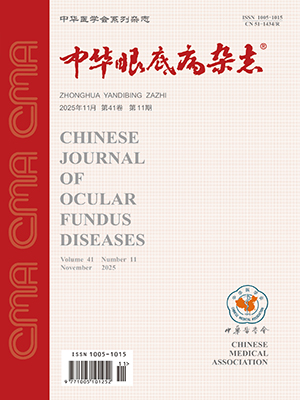| 1. |
崔芳, 王潇雨, 谢文博. 规范诊疗眼底全力护航眼健康[N]. 健康报, 2022-03-11(3).Cui F, Wang XY, Xie WB, et al. Standardize the diagnosis and treatment of fundus with all-out efforts to protect eye health[N]. Health News, 2022-03-11(3).
|
| 2. |
蔡晗, 刘丽媛, 王斐, 等. 中国乳腺癌专病队列研究: 泛共享生物样本库的建设与进展[J]. 中华流行病学杂志, 2020, 41(12): 2053-2058. DOI: 10.3760/cma.j.cn112338-20200507-00697.Cai H, Liu LY, Wang F, et al. The breast cancer cohort study in chinese women: the construction and progress of the pan-shared biobank[J]. Chin J Epidemiol, 2020, 41(12): 2053-2058. DOI: 10.3760/cma.j.cn112338-20200507-00697.
|
| 3. |
Martel A, Gastaud L, Bonnetaud C, et al. Need for a dedicated ophthalmic malignancy clinico-biological biobank: the nice ocular malignancy (NOMA) biobank[J/OL]. Cancers (Basel), 2023, 15(8): 2372[2023-04-19]. https://pubmed.ncbi.nlm.nih.gov/37190299/. DOI: 10.3390/cancers15082372.
|
| 4. |
Gangadharan C, Wills S, Vangala RK, et al. Biobanking for translational diabetes research in India[J]. Biores Open Access, 2020, 9(1): 183-189. DOI: 10.1089/biores.2019.0052.
|
| 5. |
Lacerda EM, Mudie K, Kingdon CC, et al. The UK ME/CFS Biobank: a disease-specific biobank for advancing clinical research into myalgic encephalomyelitis/chronic fatigue syndrome[J/OL]. Front Neurol, 2018, 9: 1026[2018-12-04]. https://pubmed.ncbi.nlm.nih.gov/30564186/. DOI: 10.3389/fneur.2018.01026.
|
| 6. |
Bourgeois FT, Avillach P, Kong SW, et al. Development of the precision link biobank at Boston children's hospital: challenges and opportunities[J]. J Pers Med, 2017, 7(4): 21. DOI: 10.3390/jpm7040021.
|
| 7. |
Lal S, Li A, Allen D, et al. Best practice biobanking of human heart tissue[J]. Biophys Rev, 2015, 7(4): 399-406. DOI: 10.1007/s12551-015-0182-6.
|
| 8. |
Cervo S, De Paoli P, Perin T, et al. Cost-effective organization of an institutional human cancer biobank in a clinical setting: CRO-Biobank experience toward harmonization[J/OL]. Int J Biol Markers, 2015, 30(2): e243-e251[2015-05-26]. https://pubmed.ncbi.nlm.nih.gov/25744364/. DOI: 10.5301/jbm.5000138.
|
| 9. |
Skeie JM, Tsang SH, Zande RV, et al. A biorepository for ophthalmic surgical specimens[J]. Proteomics Clin Appl, 2014, 8(3-4): 209-217. DOI: 10.1002/prca.201300043.
|
| 10. |
Reis ST, Feitosa EB, Pontes-Junior J, et al. Tumor banks: the cornerstone of basic research in urology[J]. Int Braz J Urol, 2010, 36(3): 348-354. DOI: 10.1590/s1677-55382010000300012.
|
| 11. |
张赛, 吴静, 周佳宜, 等. 妇产科专科生物样本库3.0版本的建立与管理[J]. 复旦学报(医学版), 2023, 50(3): 456-461. DOI: 10.3969/j.issn.1672-8467.2023.03.019.Zhang S, Wu J, Zhou JY, et al. Establishment and management of obstetric and gynecologic biobank 3.0[J]. Fudan Univ J Med Sci, 2023, 50(3): 456-461. DOI: 10.3969/j.issn.1672-8467.2023.03.019.
|
| 12. |
张欣冉, 张梅, 李艳英, 等. 矮小症生物样本库建立与管理[J]. 中国医药生物技术, 2023, 18(2): 162-164. DOI: 10.3969/j.issn.1673-713X.2023.02.012.Zhang XR, Zhang M, Li YY, et al. Establishment and management of a biobank for dwarfism[J]. Chin Med Biotechnol, 2023, 18(2): 162-164. DOI: 10.3969/j.issn.1673-713X.2023.02.012.
|
| 13. |
郭艺博, 刘怡文, 杨海军, 等. 高发区食管癌生物样本库的建立与管理[J]. 食管疾病, 2022, 4(1): 55-58. DOI: 10.15926/j.cnki.issn2096-7381.2022.01.014.Guo YB, Liu YW, Yang HJ, et al. Establishment and management of esophageal cancer biobank in high incidence area[J]. Journal of Esophageal Diseases, 2022, 4(1): 55-58. DOI: 10.15926/j.cnki.issn2096-7381.2022.01.014.
|
| 14. |
秦玲莎, 王欢, 张恬, 等. 地市级医院建设脑血管病专病生物样本库的可行性探讨[J]. 中国标准化, 2022, 11(22): 239-242. DOI: 10.3969/j.issn.1002-5944.2022.22.049.Qin LS, Wang H, Zhag T, et al. Discussion on the feasibility of constructing biobank for cerebrovascular diseases in prefecture-level hospitals[J]. China Standardization, 2022, 11(22): 239-242. DOI: 10.3969/j.issn.1002-5944.2022.22.049.
|
| 15. |
喻晶晶, 肖巍, 李娅妮, 等. 肝癌生物样本库的标准化建立与信息化管理[J]. 临床肝胆病杂志, 2022, 38(5): 1092-1096. DOI: 10.3969/j.issn.1001-5256.2022.05.022.Yu JJ, Xiao W, Li YN, et al. Standardized establishment and informationized management of liver cancer biobank[J]. J Chin Hepatol, 2022, 38(5): 1092-1096. DOI: 10.3969/j.issn.1001-5256.2022.05.022.
|
| 16. |
林金嬉, 梁宪红, 李上智, 等. 中国脑血管病多中心临床研究生物样本库建设模式探讨[J]. 中国卒中杂志, 2021, 16(6): 567-573. DOI: 10.3969/j.issn.1673-5765.2021.06.007.Lin JX, Liang XH, Li SZ, et al. Exploring the construction model of multi-center clinical research biobank for cerebrovascular disease in China[J]. Chin J Stroke, 2021, 16(6): 567-573. DOI: 10.3969/j.issn.1673-5765.2021.06.007.
|
| 17. |
张林, 姚品芳, 刘媛媛, 等. 湖北省肿瘤医院3.0版肿瘤生物样本库的建立与管理[J]. 中国肿瘤, 2021, 30(1): 48-53. DOI: 10.11735/j.issn.1004-0242.2021.01.A005.Zhang L, Yao PF, Liu YY, et al. Establishment and management of tumor biobank 3.0 in Hubei Cancer Hospital[J]. China Cancer, 2021, 30(1): 48-53. DOI: 10.11735/j.issn.1004-0242.2021.01. A005. DOI: 10.11735/j.issn.1004-0242.2021.01.A005.
|
| 18. |
宋金云, 赵宏宇. 不明原因肝病生物样本库的建立与管理[J]. 肝脏, 2021, 26(2): 199-201. DOI: 10.3969/j.issn.1008-1704.2021.02.027.Song JY, Zhao HY. Establishment and management of biobank for unknown etiology liver disease[J]. Chinese Hepatology, 2021, 26(2): 199-201. DOI: 10.3969/j.issn.1008-1704.2021.02.027.
|
| 19. |
Gao Z, Tan J, Wang S, et al. The xiangya ocular tumor bank: a disease-specific biobank for advancing translational research into ocular tumors[J/OL]. Front Med (Lausanne), 2022, 8: 774624[2022-01-27]. https://pubmed.ncbi.nlm.nih.gov/35155464/. DOI: 10.3389/fmed.2021.774624.
|
| 20. |
Yang P, Du L, Ye Z. How to deal with uveitis patients?[J]. Curr Mol Med, 2018, 17(7): 468-470. DOI: 10.2174/15665240186661 80207153342.
|
| 21. |
郑雪妮, 段小红. 口腔罕见病与遗传病生物样本库的建立与完善[J]. 实用口腔医学杂志, 2016, 32(6): 773-777. DOI: 10.3969/j.issn.1001-3733.2016.06.006.Zheng XN, Duan XH. Developmentofa biobank oforalraredisessesand geneticdiseases[J]. J Pract Stomatol, 2016, 32(6): 773-777. DOI: 10.3969/j.issn.1001-3733.2016.06.006.
|
| 22. |
王敏, 高志梅, 吕志宝, 等. 儿童专科医院特色生物样本库的建立与应用[J]. 中国医药生物技术, 2016, 11(3): 280-284. DOI: 10.3969/j.issn.1673-713X.2016.03.017.Wang M, Gao ZM, Lyu ZB, et al. Establishment and application of a characteristic biobank in children's specialized hospitals[J]. Chin Med Biotechnol, 2016, 11(3): 280-284. DOI: 10.3969/j.issn.1673-713X.2016.03.017.
|
| 23. |
Yang Y, Liu YM, Wei MY, et al. The liver tissue bank and clinical database in China[J]. Front Med China, 2010, 4(4): 443-447. DOI: 10.1007/s11684-010-0190-7.
|
| 24. |
Li H, Qiu Y, Zhang X, et al. Establishment of a lung cancer biobank of a southern chinese population[J]. J Thorac Dis, 2009, 1(1): 17-22.
|
| 25. |
丁玲, 丁斐, 王钊, 等. 生物样本库行业管理规范[M]//陈曲波. 生物样本库信息系统功能设计与实践. 北京: 人民卫生出版社, 2022: 1-10.Ding L, Ding F, Wang Z, et al. Biobank industry management standard[M]//Chen QB. Functional design and practice of biobank information system. Beijing: People's Health Publishing House, 2022: 1-10.
|
| 26. |
国家卫生健康委关于印发“十四五”全国眼健康规划(2021-2025年)的通知. 国卫医发〔2022〕1号. 2022-01-04. https://www.gov.cn/zhengce/zhengceku/2022-01/17/content_5668951.htm.Circular of the National Health Commission on the issuance of the National Eye Health Plan for the 14th Five-Year Plan (2021-2025). National Health and Medical Development [2022] No. 1. 2022-01-04. https://www.gov.cn/zhengce/zhengceku/2022-01/17/content_5668951.htm.
|
| 27. |
王乐, 刘苏来, 蒋宇, 等. 肿瘤生物样本库的发展现状及探讨[J]. 现代肿瘤医学, 2020, 28(5): 832-835. DOI: 10.3969/j.issn.1672-4992.2020.05.033.Wang L, Liu SL, Jiang Y, et al. Development status and discussion of biobank[J]. Modern Oncology, 2020, 28(5): 832-835. DOI: 10.3969/j.issn.1672-4992.2020.05.033.
|




